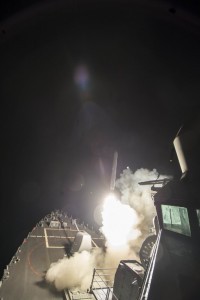The U.S. military attacked a Syria-government airfield with 59 tomahawk missiles on Thursday evening.
The missiles targeted the Shayrat Airfield near Homs, and were in response to a Tuesday chemical weapons attack. Officially announcing the strike, President Donald Trump said that the targeted airfield had launched the chemical attack on a rebel-held area, and he called on other nations to oppose Syria’s embattled leader.
“On Tuesday, Syrian dictator Bashar al-Assad launched a horrible chemical weapons attack on innocent civilians. Using a deadly nerve agent, Assad choked out the lives of helpless men, women and children. It was a slow and brutal death for so many. Even beautiful babies were cruelly murdered in this very barbaric attack,” Trump said during a Thursday address.
A U.S. defense official called the U.S. strike a “one-off,” Reuters reported.
On Thursday, Secretary of State Rex Tillerson said that Russia had failed to carry out a 2013 agreement to secure Syrian chemical weapons, adding that Moscow was either complicit or incompetent in its ability to uphold that deal.
Tillerson said that the U.S. had a high degree of confidence that sarin nerve gas had been used in Tuesday’s chemical attack in northern Syria.
The Pentagon released details on the strike, saying it was conducted using tomahawk missiles launched from the destroyers USS Porter and USS Ross in the Eastern Mediterranean Sea.
“A total of 59 [Tomahawk Land Attack Missiles] targeted aircraft, hardened aircraft shelters, petroleum and logistical storage, ammunition supply bunkers, air defense systems, and radars,” the Pentagon said in a statement. “As always, the U.S. took extraordinary measures to avoid civilian casualties and to comply with the Law of Armed Conflict.”
The Pentagon called the strike a “proportional response to Assad’s heinous act.”
There was no immediate word on casualties, but no people were targeted, an official told NBC.
One U.S. official told NBC that the Russians were warned ahead of the strike. Additionally, no Russian assets were targeted, according to the report.
Still, Tillerson said the U.S. “sought no approval from Moscow” on the strikes.
Syrian armed rebels welcomed the strike. Ahrar Al Sham, an opposition group backed by Gulf states responded: “The armed opposition welcomes any U.S. intervention through surgical strikes that would deter the Assad regime capabilities to kill civilians and shorten the suffering of our people.”
Syrian state TV, meanwhile, said, “American aggression targets Syrian military targets with a number of missiles.”
Earlier Thursday, Reuters reported that a British diplomat had said the United Nations Security Council would not vote on Thursday on a draft resolution to condemn Tuesday’s gas attack, but will continue negotiations.
Russia’s deputy U.N. envoy, Vladimir Safronkov, warned that day of “negative consequences” if the U.S. carried out military strikes on Syria over the attack.
“We have to think about negative consequences, negative consequences, and all the responsibility if military action occurred will be on shoulders of those who initiated such doubtful and tragic enterprise,” Safronkov told reporters when asked about possible U.S. strikes, adding that such consequences could be seen in Iraq and Libya.
U.S. Sen. Marco Rubio appeared to be tweeting about an American offensive action in Syria, posting at 8:44 p.m. ET, “‘Be sure of this: The wicked will not go unpunished’ Proverbs 11:21 # SyriaChemicalAttack”
The United States, Britain and France proposed a draft U.N. resolution on Tuesday to condemn the attack and press Syria to cooperate with international investigators. Russia said the text was unacceptable and proposed a rival draft.
In February, Syrian ally Russia, backed by China, cast its seventh veto to protect Assad’s government from council action, blocking a bid by Western powers to impose sanctions over accusations of chemical weapons attacks. China has vetoed six resolutions on Syria.
A Security Council resolution needs nine votes in favor and no vetoes by the United States, Britain, France, Russia or China to pass.







































